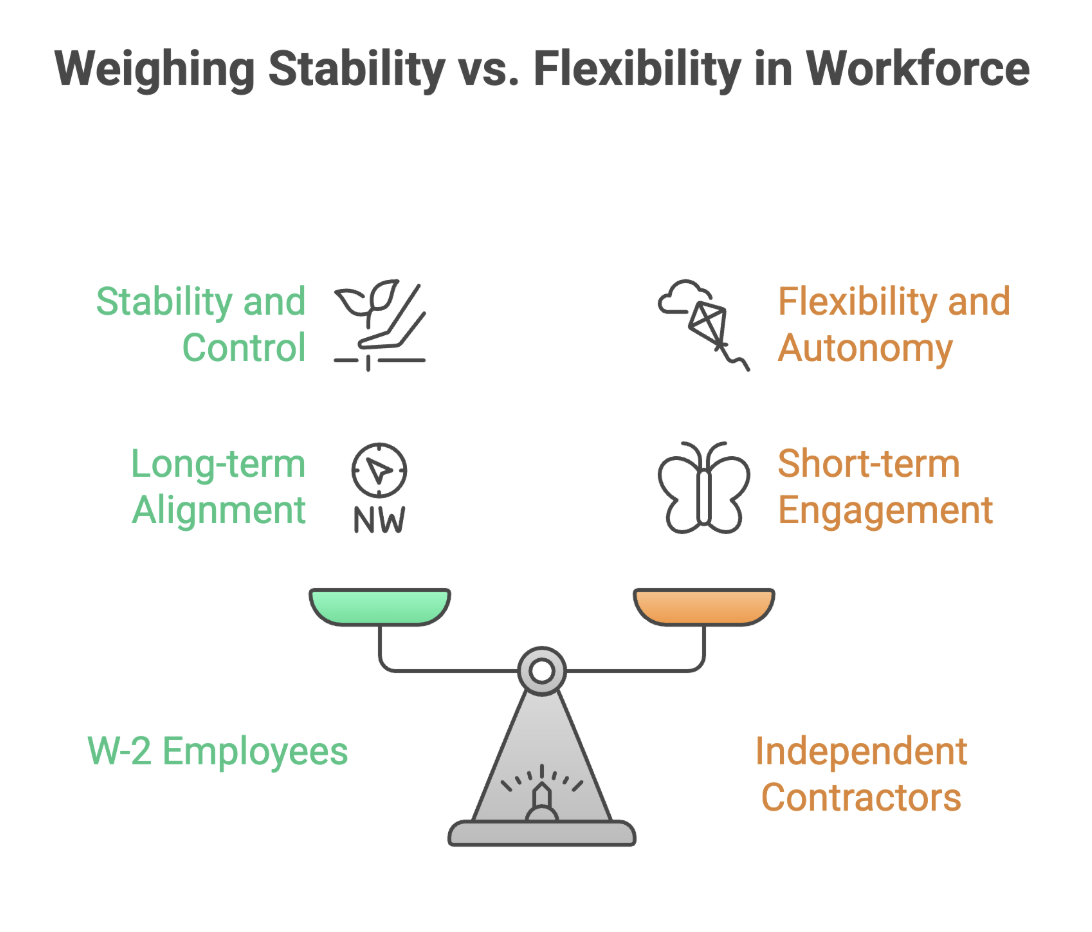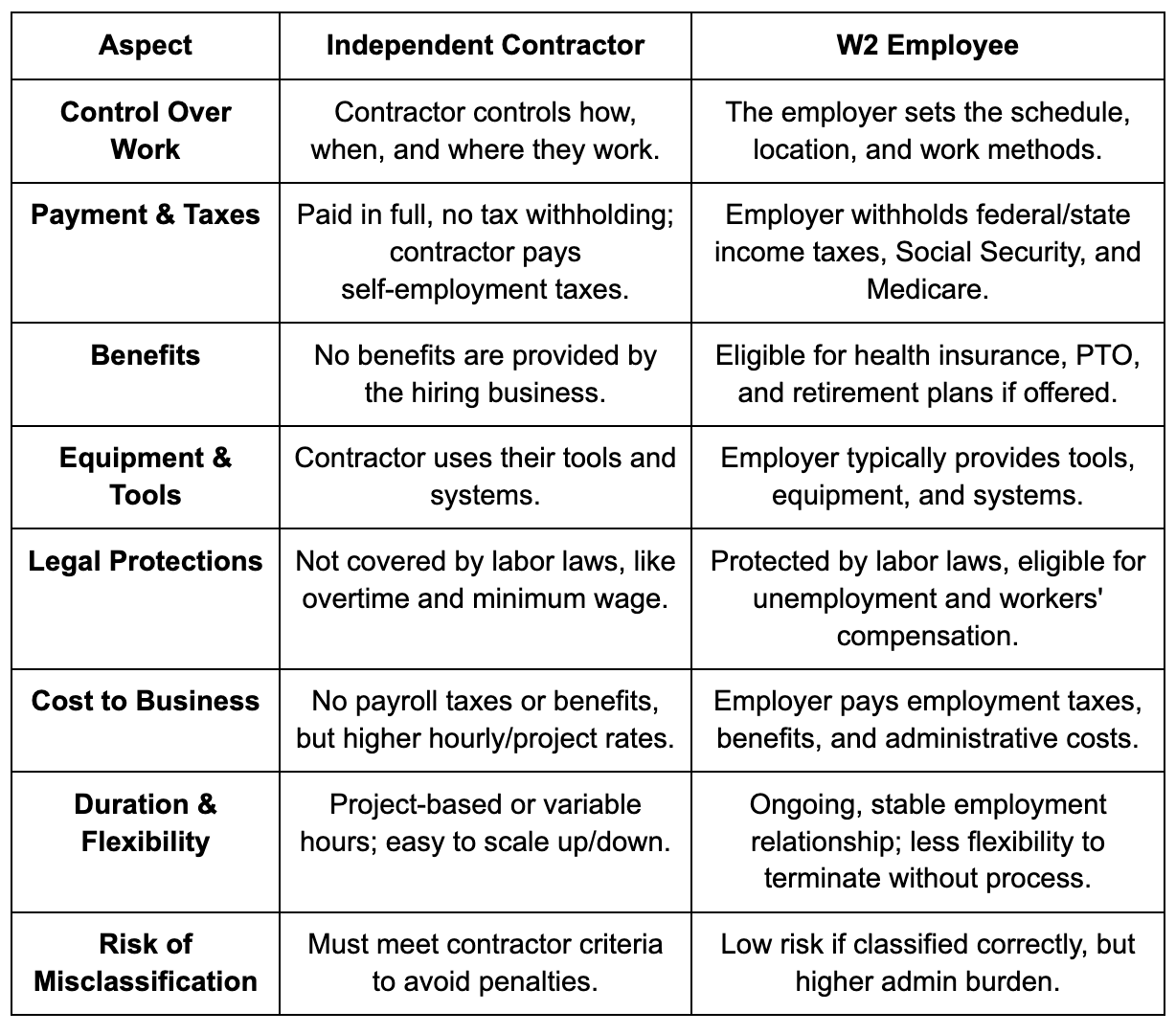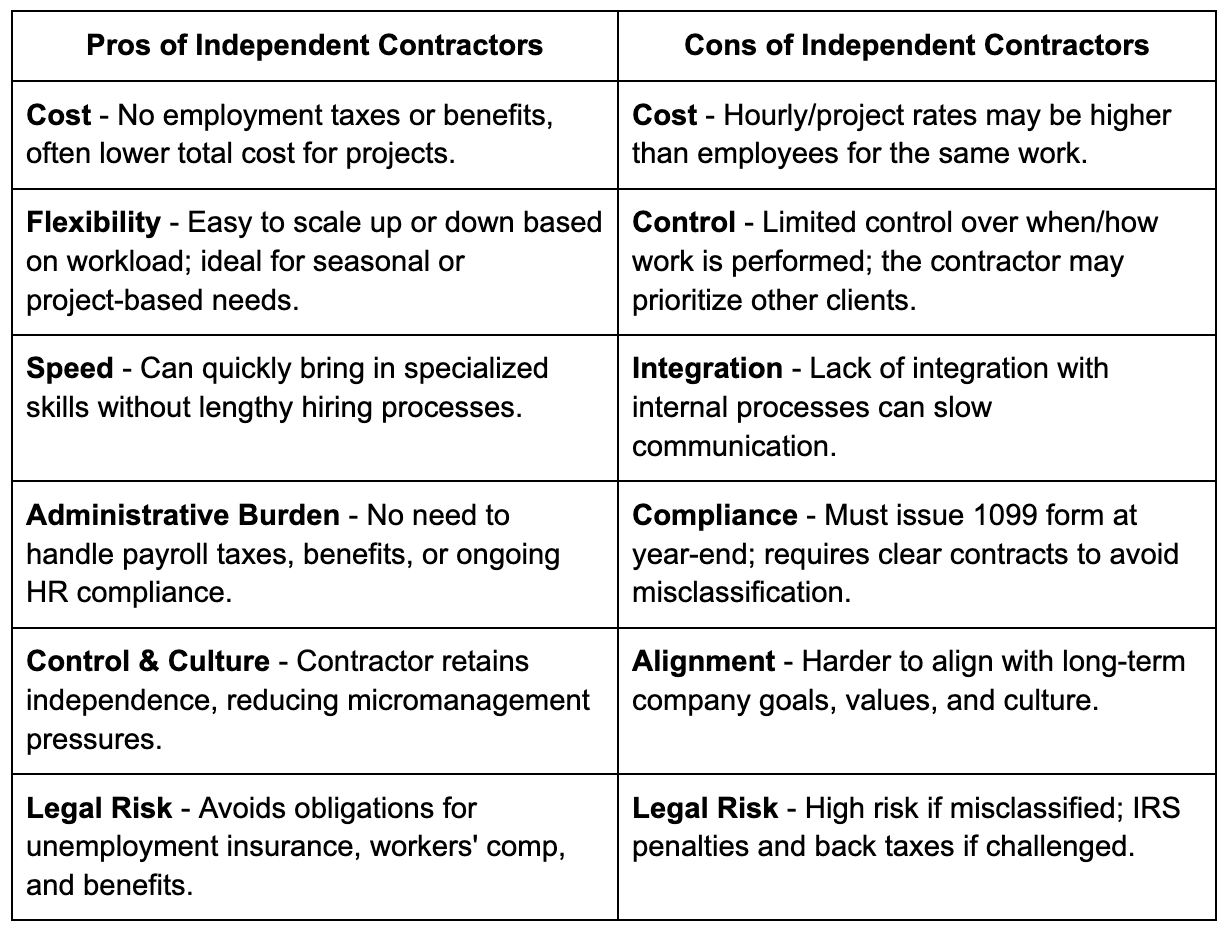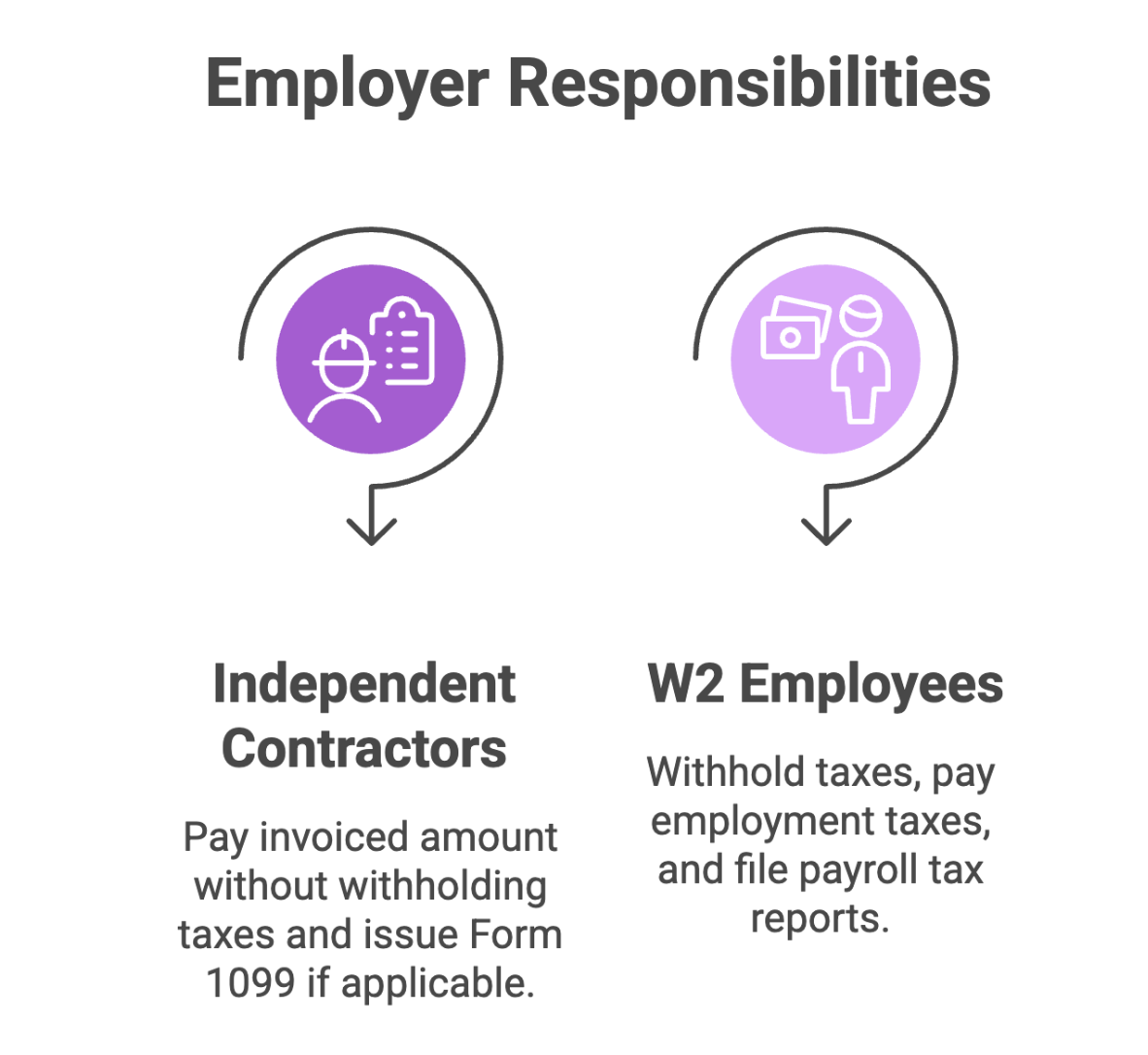If you're a founder or business owner ready to grow your team, the 1099 vs. W-2 employee question isn't just a checkbox decision, it's a strategic fork in the road that can shape your business's flexibility, compliance risks, and long-term costs.
Hire too many independent contractors, and you might face IRS scrutiny and struggle with inconsistent output. Hire W2 employees too early, and you could drain cash flow on benefits and payroll taxes before your revenue is ready.
Understanding the difference between W-2 and 1099 workers isn't about tax forms alone. It's about choosing the right mix of stability and agility, controlling your operational costs, and ensuring your hiring practices align with your business model.
In this guide, you'll learn:
Whether you're scaling a startup team, hiring your first content writer, or expanding your operations team, understanding the 1099 vs. W-2 hiring decision will help you build your team the smart way, without surprises later.
An independent contractor is a self-employed worker you hire for specific projects or ongoing work, but unlike employees, they aren't on your payroll. Instead, they handle their own taxes, benefits, and working processes, offering you flexibility and often lower overhead.
The term "1099" comes from Form 1099, which businesses use to report nonemployee compensation made to contractors at year-end. But understanding what an independent contractor truly is goes far beyond the form.
Independent contractors are self-employed, meaning:
For example, if you hire a freelance graphic designer to create branding assets, they decide when and how they complete the designs, as long as they meet your deadlines and deliverables.
The right to control how work is performed is one of the key factors the Internal Revenue Service uses when determining the type of worker classification.
While many think of contractors for one-off projects, many businesses engage independent contractors for ongoing work, such as:
However, even in ongoing relationships, the contractor maintains autonomy over how the work performed is completed, which is a key legal distinction.
1099 independent contractors:
This means you do not deduct income tax, Social Security, or Medicare taxes when making payments to independent contractors. Instead, contractors are responsible for calculating and paying their own self-employment taxes and income to the IRS and state.
Unlike W-2 employees, 1099 workers:
While this can reduce your costs, it requires clear agreements and expectations, ensuring you aren't treating workers as employees, which could trigger misclassification issues with the IRS or state labor departments.
In these cases, you gain expertise without long-term commitments, allowing your business to remain agile while scaling output as needed.
The independent contractor model is attractive for founders who:
However, this flexibility comes with the responsibility to structure contractor relationships carefully, ensuring you comply with classification rules to avoid potential penalties.
A W2 employee is a full-time or part-time worker directly employed by your business, appearing on your payroll and receiving wages with taxes withheld. The term "W-2" comes from W-2 forms, which employers use to report an employee's annual wages and tax withholdings each year.
While independent contractors offer flexibility, W2 employees provide stability, control, and long-term alignment for your business as it grows.

Unlike contractors, you have direct and control over how, when, and where W-2 employees perform their work. This includes:
For example, if you hire a full-time marketing coordinator, you determine their working hours, the platforms they use, and the priorities they should focus on each week.
This control is one of the key legal distinctions that differentiates a worker as an employee from a contractor under common law rules.
When you hire W2 employees:
This means employees do not need to worry about paying estimated quarterly taxes on their wages, unlike contractors. For founders, it means added administrative responsibilities, but it also ensures your business complies with federal and state payroll regulations.
The taxes for W-2 employees include both employee and employer portions, where you pay half of the Social Security and Medicare taxes while the employee pays the other half through payroll deductions.
W2 employees may be eligible for:
Additionally, employees are protected under labor laws, including minimum wage requirements, workplace safety regulations, and anti-discrimination laws enforced by the Department of Labor.
In these scenarios, the business benefits from consistent availability, deeper integration into the company's culture, and clear alignment with long-term goals.
Many founders opt to hire W-2 employees when:
While the cost of benefits and payroll taxes makes W2 employees more expensive on paper, the stability and control they provide can be crucial for businesses scaling with intention.
Choosing between hiring an independent contractor or a W-2 employee isn't just a matter of preference; it shapes how you manage your team, budget, and compliance risk.
Here is a detailed breakdown to help you understand how these two types of workers differ in practice:

Understanding the differences between these two types of workers helps you make informed decisions about your workforce structure and avoid potential compliance issues.
Hiring independent contractors can be a smart move for many startups and small businesses, but it's important to weigh flexibility against potential limitations and compliance risks.

When you hire workers as independent contractors, remember that independent contractors are responsible for their own taxes, benefits, and work methods, which can reduce your administrative burden but requires careful management of the working relationship.
Hiring W2 employees provides stability and long-term alignment for your business but comes with higher costs and responsibilities. Understanding these trade-offs helps you decide when W-2 employee classification is worth the investment.

When you classify a worker as an employee, you gain greater control but also take on additional responsibilities for employment taxes, benefits, and compliance with federal and state regulations.
Choosing between an independent contractor and a W-2 employee doesn't have to feel overwhelming. Use this simple 4-question framework to guide your decision:
Project-Based or Temporary? Consider an independent contractor
Ongoing, Core Business Function? Consider a W2 employee
Need flexibility, minimal oversight, and output-focused delivery? An independent contractor may fit.
Need to set schedules, methods, and integrate with your team? A W2 employee is better.
Irregular cash flow, need cost flexibility? An independent contractor can help you manage costs.
Stable revenue, ready for long-term team investment? A W2 employee may align with your goals.
Confident in maintaining contractor independence and using clear contracts? An independent contractor can work well.
Want to reduce misclassification risk and are prepared to handle payroll and benefits? A W2 employee is safer.
Understanding the tax and compliance differences between independent contractors and W2 employees is critical. Missteps here don't just cause headaches, they can lead to IRS penalties, back taxes, and legal issues that drain your cash and time.

For Independent Contractors:
For W2 Employees:
The IRS uses three main categories to determine whether a worker is an employee or an independent contractor:
If you're unsure about classification, you can file Form SS-8 with the IRS to request an official determination.
Misclassifying employees as independent contractors can lead to:
The IRS actively monitors worker classification, especially in industries with a high mix of contractors and employees. Misclassifying employees can result in significant financial penalties.
If you've been misclassifying workers, the IRS offers a Voluntary Classification Settlement Program (VCSP) that allows you to reclassify their workers as employees for future tax periods with partial relief from federal employment taxes.
If you're unsure about how to determine whether a worker should be classified as an employee or independent contractor, it is far safer to seek professional advice rather than risk penalties later. The distinction between a contractor and an employee has significant implications that are filed with the IRS and affect your business's compliance obligations.
When building your team, it's important to understand that there are different types of employees and worker classifications beyond the basic W-2 or 1099 distinction.
Most businesses will work with these two types of workers:
However, there's also a special category called a statutory employee, which is someone who is treated as an employee for Social Security and Medicare tax purposes but as an independent contractor for federal income tax purposes.
Whether you classify someone as a W-2 employee or a 1099 independent contractor affects:
Understanding these distinctions helps you make informed decisions about your workforce and avoid potential compliance issues with tax authorities.
Deciding between independent contractors and W2 employees isn't just about paperwork, it's about building a team that aligns with your business's growth goals, cash flow, and compliance responsibilities.
If you need flexibility and project-based support, independent contractors can help you scale quickly while managing costs.
If you need long-term stability and control, W2 employees can help you build a committed team aligned with your mission.
The key is to align your hiring strategy with your operational needs and financial capacity, while ensuring compliance to avoid penalties and stress later. Remember that misclassifying workers can result in significant consequences, so when in doubt, consult with professionals who understand employment tax requirements and worker classification rules.
At Madras Accountancy, we help founders and growing businesses navigate payroll, tax compliance, and fractional CFO support, ensuring your hiring decisions align with your financial and operational strategy.
Whether you're setting up payroll for your first employee or need clarity on managing contractor payments, we're here to help you stay compliant while scaling with confidence.
Get in touch with Madras Accountancy to build your compliant, scalable hiring structure today.
Question: What are the fundamental differences between 1099 contractors and W-2 employees?
Answer: The fundamental differences between 1099 contractors and W-2 employees center on control, benefits, and tax obligations. W-2 employees work under company direction, receive benefits like health insurance and paid time off, and have taxes withheld from paychecks. 1099 contractors operate independently, control their work methods, handle their own taxes and benefits, and typically work on project-based arrangements. Employees cost more due to benefits and payroll taxes, while contractors offer flexibility but require careful classification compliance.
Question: When should businesses hire W-2 employees instead of 1099 contractors?
Answer: Businesses should hire W-2 employees when they need ongoing work relationships, direct control over work methods and schedules, and integration with company culture and operations. Choose employees for core business functions, positions requiring extensive training, customer-facing roles, and jobs needing immediate supervision. W-2 classification is appropriate when providing company equipment, setting specific work hours, requiring exclusive services, or when work involves proprietary processes that require confidentiality and loyalty.
Question: What are the cost differences between hiring 1099 contractors versus W-2 employees?
Answer: W-2 employees typically cost 25-40% more than their base salary due to payroll taxes, benefits, workers' compensation, unemployment insurance, and overhead expenses. For a $50,000 salary, total costs often reach $62,500-$70,000 annually. 1099 contractors charge higher hourly rates but eliminate payroll taxes, benefits, and administrative costs. However, contractors may lack availability during critical periods and require more project management. Consider both direct costs and indirect expenses when comparing these employment options.
Question: How do tax implications differ between 1099 contractors and W-2 employees for businesses?
Answer: Businesses paying W-2 employees must withhold federal, state, and local income taxes, plus pay employer portions of Social Security, Medicare, unemployment taxes, and workers' compensation premiums. For 1099 contractors, businesses only report payments exceeding $600 annually via Form 1099-NEC without withholding taxes or paying employment taxes. However, misclassification can result in back taxes, penalties, and interest. Contractors handle their own tax obligations, including self-employment taxes of 15.3% on net earnings.
Question: What legal risks exist with 1099 contractor classification and how can businesses mitigate them?
Answer: Legal risks with 1099 contractor classification include IRS audits, Department of Labor investigations, state tax assessments, and worker misclassification lawsuits. Businesses face penalties for unpaid payroll taxes, benefits claims, and workers' compensation violations. Mitigate risks by maintaining detailed contractor agreements, documenting work independence, ensuring contractors serve multiple clients, avoiding employee-like control, and conducting periodic classification reviews. Consider legal consultation for complex situations and maintain comprehensive records supporting independent contractor relationships.
Question: Can businesses convert 1099 contractors to W-2 employees and what's the process?
Answer: Businesses can convert 1099 contractors to W-2 employees through a structured transition process. Begin by evaluating the business need for employee status, determining appropriate compensation and benefits, and preparing employee onboarding materials. Complete Form W-4 for tax withholding, establish payroll processing, provide required employee handbook and policies, and terminate contractor agreements appropriately. Ensure compliance with employment laws, update job descriptions, and communicate changes clearly to avoid confusion about new employment relationship expectations.
Question: How do benefits and job security compare between 1099 contractors and W-2 employees?
Answer: W-2 employees receive comprehensive benefits including health insurance, retirement contributions, paid time off, unemployment insurance, and workers' compensation protection. They enjoy greater job security, legal protections, and career development opportunities within organizations. 1099 contractors typically earn higher hourly rates but lack benefits, job security, and legal protections. They must provide their own insurance, retirement planning, and handle irregular income streams. However, contractors gain flexibility, diverse client exposure, and potential for higher overall earnings.
Question: What documentation requirements apply to 1099 contractors versus W-2 employees?
Answer: W-2 employees require Form W-4 for tax withholding, I-9 for employment eligibility verification, employee handbook acknowledgment, and benefits enrollment forms. Maintain personnel files, performance reviews, and payroll records. 1099 contractors need Form W-9 for taxpayer identification, independent contractor agreements, invoices and payment records, and project deliverables documentation. File Form 1099-NEC annually for payments exceeding $600, maintain Form 1096 as summary transmittal, and document the independent nature of work relationships.
.png)
December 9, 2025
A straight-talking overview of five small business tax prep options in 2025, including Madras Accountancy, TurboTax, H&R Block, TaxSlayer, and Bench’s books-plus-tax model.

December 9, 2025
An on-the-ground guide to the UK’s fractional CFO ecosystem – London and beyond – including The CFO Centre, fin-house, FD Capital, BKL, BSmart, and how Madras Accountancy fits into cross-border and hybrid models.